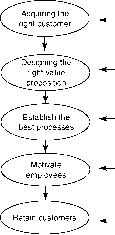Exchange relationships in marketing
Most marketing exchanges between the organization and its customers are characterized by transactions involving a product or service being sold for money where the latent reasons for the transaction are economic, social and psychological in nature. Based on this latent structure, marketing exchanges may be economic, symbolic or some combination of the two. Marketing exchange as economic is built on the concept of economic man which assumes that people:
■ are rational in behaviour;
■ attempt to maximize satisfaction through exchange;
■ possess complete information on alternatives available to them; and that
■ exchanges are reasonably free from outside influences.
Symbolic exchange, in contrast, refers to the mutual transfer of psychological, social or other intangible benefits associated with products and services. 'People buy things not only for what they can do, but also for what they mean' (Levy 1959, p. 118). But experience demonstrates that marketing exchanges involve economic and symbolic dimensions which are often quite difficult to separate. Successful transactions depend on deriving an appropriate mix of the two. Customers seek economic and symbolic rewards in their purchases and relationships with organizations which leads to the suggestion of the existence of a marketing person (Bagozzi 1975, p. 37) who:
■ is sometimes rational, sometimes irrational;
■ is motivated by tangible and intangible rewards;
■ engages in economic and symbolic exchanges;
■ faces incomplete information;
■ strives to maximize benefits but settles for less than optimum gains in exchanges;
■ is constrained by individual and social factors. Transactions and relationships
A fallacy that is perpetuated among business commentators and readily believed by chief executive officers of many organizations is that customer relationship management (CRM), requiring large sophisticated databases of customer information, is the panacea for establishing customer loyalty. Without an emphasis on technology or software, CRM aligns business processes with customer strategies to build customer loyalty and increase profits over time.
Customer relationship management is not a software tool that manages customer relationships but is rather the bundling of customer strategies and processes, supported by relevant software, for the purpose of improving customer loyalty and eventually profits in the organization. Effective customer relationship management is based on segmentation analysis and an appropriate customer strategy for each segment. According to Rigby etal. (2002, p. 109) 'successful CRM depends more on strategy than on the amount spent on technology. ... The only way you can make CRM work is by taking the time to calculate your customer strategy, which helps employees understand where they are going and why, and to align your business processes before implementing technology.' These authors provide a framework to ensure an appropriate alignment of CRM strategy with technology. Five steps lead to the successful retention of customers (Figure 2.3). First, it is necessary to acquire the right customer, which depends on selecting an appropriate strategy supported by suitable technology. During the next stage the organization develops the right value proposition after which it establishes the best processes. It is then necessary to involve employees in the task of retaining customers.
Customer relationship management, loyalty programmes, relationship marketing, life-time customer value are, therefore, fashionable terms used by commentators and managers who ignore the importance of the sale - the transaction - as the primary purpose of multiple communications with customers. A focus on the transaction provides immediate feed-back on the effectiveness of marketing activities. It also serves to prequalify customers
Imperative
Technology
Imperative

Technology
|
Strategy |
■ analysis of customer revenue and costs ■ identify current and future high-value customers ■ target direct marketing | |
|
■ identify most valuable customers ■ determine their importance to you | ||
|
■ select products required now and in the future ■ identify competing products ■ determine products to offer |
■ collect relevant product behaviour data ■ create new distribution channels ■ develop new pricing models ■ build communities of customers | |
|
■ determine the best way to deliver the products ■ role for alliances and technologies ■ service capabilities to develop or acquire | ||
|
■ process transactions faster ■ provide better information to the front office ■ efficient management of logistics and supply chain ■ install effective collaboration | ||
|
■ understand tools employees need to foster customer relationships ■ establish human resource systems to increase employee loyalty | ||
|
■ align incentives and performance measures ■ use knowledge management systems | ||
|
■ understand why customers defect and how to re-acquire them ■ understand what competitors do to win organization's high-value customers ■ service managers study customer defection measures | ||
|
- |
■ track customer defection and retention levels | |
Source: adapted from Darrell K., Rigby, Frederick F. Reichheld and Phil Schefter (2002), 'Avoid the four perils of CRM', Harvard Business Review, February, p.106. Reprinted by permission of Harvard Business Review. Copyright ©2002 by the Harvard Business School Publishing Corporation; all rights reserved.
Source: adapted from Darrell K., Rigby, Frederick F. Reichheld and Phil Schefter (2002), 'Avoid the four perils of CRM', Harvard Business Review, February, p.106. Reprinted by permission of Harvard Business Review. Copyright ©2002 by the Harvard Business School Publishing Corporation; all rights reserved.
Figure [2.3] Customer relationship management strategy and technology and measure their potential value before the organization invests in building a relationship with them. Relationship marketing aims to create a customer relationship from the start of the sales cycle and satisfy and retain existing customers whereas the goal of transactional marketing is to make the sale and locate new customers.
Advocates of relationship marketing or customer relationship management believe that the approach delivers accurate data to the organization to assist in making decisions but in fact these data are unfiltered because they are not calibrated against any benchmarks or standards. There is, however, a clear relationship between the transactional activities of an organization and resulting revenues. Observing customer behaviour rather than basing decisions on attitudes seems the better option.
Transactional marketing techniques should be used as a precursor to relationship building efforts as retaining customers ultimately is more profitable than searching for new ones. In this regard the ability of transactional marketing to prequalify customers is the approach favoured.
Customer loyalty and profitability
The relationship between customer loyalty and profitability is much weaker and more subtle than proponents of loyalty programmes claim. Loyalty programmes are based on three assumptions: that it costs less to serve loyal customers; that loyal customers pay higher prices for the same bundle of goods; and that loyal customers through good word-of-mouth communication, promote the organization (Reinartz and Kumar 2002). In regard to the first assumption, many advocates of loyalty programmes claim that loyal customers are profitable because the initial costs of recruiting them are amortized over a larger number of transactions. This assumes that these transactions are profitable. It is necessary to test for a direct link between loyalty and costs. No doubt there are circumstances where such links exist but the organization should determine the circumstances in which loyalty programmes are profitable.
The second assumption depends on high switching costs among some customer groups whereby they are willing to pay higher prices to avoid making the switch. In practice, loyalty is rewarded with discounts so just because a customer is willing to pay a relatively high price does not mean that the organization will benefit from this loyalty.
Under the third assumption loyal customers should promote the organization. The idea that more frequent customers are also the strongest advocates for the organization holds a great attraction for managers. Many organizations justify their investments in loyalty programmes by seeking profits not so much from the loyal customers as from the new customers the loyal ones attract. Furthermore, loyal customers may have formed a positive attitude toward the organization which they pass along to new customers. As noted previously, however, the organization must study customer behaviour, not just attitudes to determine the effectiveness of loyalty programmes.
Continue reading here: Stages in the product life cycle
Was this article helpful?

